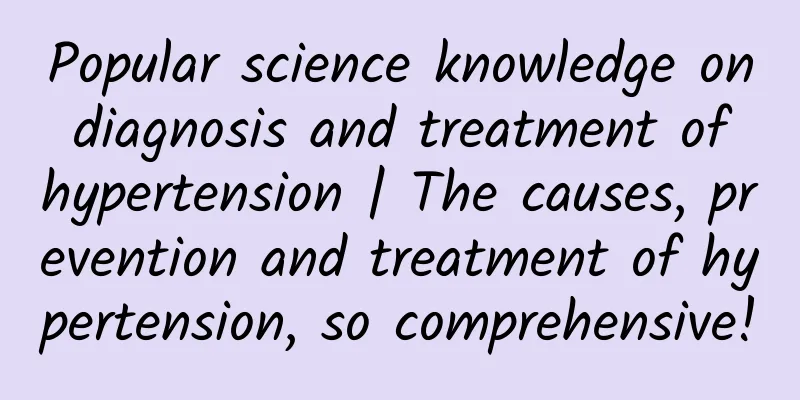Popular science knowledge on diagnosis and treatment of hypertension | The causes, prevention and treatment of hypertension, so comprehensive!

|
May 17, 2021 is the 17th "World Hypertension Day". With the influence of various factors such as eating habits in recent years, people have found that more and more people around them seem to say that they have high blood pressure and have to take antihypertensive drugs all the time. Everyone may have some doubts. How does the doctor determine whether a person has hypertension? Why do those hypertensive patients have to take antihypertensive drugs on time? Today we will learn about the diagnosis and treatment of hypertension. When we talk about hypertension, the literal meaning is that the blood pressure is elevated. So what is this elevated "blood pressure"? The contraction and relaxation of the human heart are performed alternately, which pushes the blood to flow continuously in the closed circulation system composed of the heart and blood vessels. The blood flows in the blood vessels, and the blood in the blood vessels exerts a certain lateral pressure on the blood vessel wall. This lateral pressure is what we call blood pressure. In fact, the blood pressure in the population is continuously normally distributed, and there is no clear boundary between normal blood pressure and hypertension. Therefore, the current standard for doctors to diagnose hypertension is defined based on clinical and epidemiological data. According to the latest expert consensus, doctors will use the results of office blood pressure measurements as the main basis for diagnosis. If the blood pressure measured by doctors or nurses in the outpatient department or inpatient department of the hospital on different 3 days, the so-called "office blood pressure", shows that the systolic pressure is greater than or equal to 140 mmHg and the diastolic pressure is greater than or equal to 90 mmHg, they will be diagnosed with hypertension. This situation often occurs in life. Some people say that they have never measured their blood pressure before. The first time they measured their blood pressure in the hospital, they found that their systolic pressure was ≥140 mmHg and their diastolic pressure was ≥90 mmHg, or their systolic pressure was ≥140 mmHg but their diastolic pressure was <90 mmHg. There are also three situations in which their systolic pressure <140 mmHg is normal but their diastolic pressure is ≥90 mmHg. At this time, although his blood pressure does not meet the standard for diagnosis of hypertension, his blood pressure condition is not very good. Doctors generally recommend that patients have a reexamination twice within 4 weeks to see the blood pressure values measured again to further determine whether they can be diagnosed with hypertension. Everyone must pay attention to the fact that the main basis for diagnosis here is the blood pressure measurement results in the clinic, and self-measured blood pressure at home is generally used as the main means of self-management for patients. It can also be used for auxiliary diagnosis, but it cannot be the main basis for diagnosing hypertension. In medicine, doctors use whether the cause of hypertension is clear as the standard to divide hypertension into two categories: secondary hypertension and primary hypertension. Secondary hypertension generally refers to high blood pressure caused by certain diseases or causes, accounting for about 5% to 10% of all hypertension, but with the continuous improvement of diagnostic methods, this proportion is still rising. Another type of hypertension with unclear causes is called primary hypertension. There are many causes of secondary hypertension. At least 50 diseases can lead to secondary hypertension, such as renal parenchymal hypertension, renal vascular hypertension, pheochromocytoma, primary aldosteronism, pregnancy-induced hypertension, drug-induced hypertension, etc. Most secondary hypertension can be cured through etiological treatment. The etiology of primary hypertension is generally multifactorial, especially the result of the interaction of genetic and environmental factors, but it is not clear how genetic and environmental factors raise blood pressure. On the one hand, genetic factors are manifested in the obvious familial aggregation of hypertension. If parents have hypertension, the incidence rate of their children is as high as 46%, and about 60% of hypertensive patients have a family history of hypertension. On the other hand, environmental factors are related to diet, mental stress and smoking. The average sodium intake in the diet is significantly positively correlated with the prevalence of hypertension; high protein intake is a blood pressure-raising factor; alcohol consumption is linearly correlated with blood pressure levels, especially with systolic blood pressure; saturated fatty acids in the diet are also a blood pressure-raising factor. Other factors such as weight gain are also risk factors for high blood pressure. Obesity types are closely related to hypertension, and abdominal obesity is prone to hypertension. Some drugs can also cause high blood pressure, such as oral contraceptives, licorice, non-steroidal anti-inflammatory drugs, etc. Clinical studies have shown that hypertension is not a homogeneous disease, and the causes and pathogenesis vary from individual to individual. Current studies have shown that the main possible mechanisms include neural mechanisms, renal mechanisms, hormone mechanisms, vascular mechanisms, insulin resistance, etc. The content involved is too professional and we will not discuss it in detail here. So how to treat hypertension? Unfortunately, there is no cure for primary hypertension, so you may need to take medication on time for a long time to maintain stable blood pressure. The main purpose of our treatment of hypertension is to reduce the occurrence of cardiovascular and cerebrovascular complications and the risk of death. It is generally advocated that the blood pressure of hypertensive patients should be reduced to below 140/90 mmHg. However, for patients with diabetes, coronary heart disease, heart failure, chronic kidney disease and proteinuria, if they can tolerate it, their blood pressure should be reduced to below 130/80 mmHg; patients aged 65 to 79 should have their blood pressure reduced to below 150/90 mmHg, and if they can tolerate it, their blood pressure can be further reduced to below 140/90 mmHg; patients aged 80 and above can have their blood pressure reduced to below 150/90 mmHg. The general treatments for hypertension are: 1. Lifestyle intervention. We mentioned earlier that environmental factors such as diet, mental stress, smoking, and obesity are closely related to hypertension. Therefore, for patients diagnosed with hypertension, lifestyle intervention should be started immediately and adhered to for a long time, that is, the "six steps of a healthy lifestyle" - limit salt, lose weight, exercise more, quit smoking, quit drinking, and keep a calm mind. Studies have shown that some lifestyle intervention methods can clearly lower blood pressure, such as reducing sodium intake, losing weight, and regular moderate-intensity exercise (such as brisk walking, jogging, cycling, swimming, Tai Chi and other common fitness methods) have a direct blood pressure-lowering effect. Quitting smoking and drinking can directly reduce the risk of cardiovascular disease and is strongly advocated. In addition, doctors assisting patients in reducing mental stress and maintaining psychological balance is also an important aspect of improving treatment effectiveness. 2. Drug treatment. First of all, the timing of drug treatment is very important. The latest guidelines suggest that all hypertensive patients, once diagnosed, are advised to start drug treatment immediately while intervening in lifestyle. However, for hypertensive patients with only systolic blood pressure <160 mmHg and diastolic blood pressure <100 mmHg and without coronary heart disease, heart failure, stroke, peripheral atherosclerosis, kidney disease or diabetes, doctors will also suspend medication according to the condition and the patient's wishes, and adopt simple lifestyle intervention for up to 3 months. If the target is still not reached, drug treatment will be started again. Secondly, in terms of the selection of antihypertensive drugs, five major categories of antihypertensive drugs (A, B, C, D) with clear evidence and prognosis are generally used, namely ACEI, ARB, beta-blockers, CCB and diuretics. These five types of drugs have different characteristics for lowering blood pressure. A refers to ACEI and ARB. These two types of drugs have clear antihypertensive effects, especially for patients with heart failure, post-myocardial infarction, diabetes, and chronic kidney disease. There is sufficient evidence to prove that they can improve prognosis. However, patients with severe renal insufficiency and hyperkalemia, pregnant or planning pregnancy are prohibited. B is a beta-blocker. It can reduce heart rate, especially for patients with a fast heart rate. It can improve the prognosis of patients with myocardial infarction or heart failure. It can relieve angina symptoms in patients with coronary heart disease and exertional angina pectoris. It is contraindicated in patients with severe bradycardia and bronchial asthma. C: CCB is a so-called calcium channel blocker. Common drugs include amlodipine, nifedipine sustained-release tablets or controlled-release tablets, and felodipine sustained-release tablets. This type of drug has a strong antihypertensive effect, good tolerance, no absolute contraindications, and a relatively wide range of applications. It is more suitable for elderly patients with isolated systolic hypertension. Common adverse reactions include headache, facial flushing, ankle edema, rapid heartbeat, gingival hyperplasia, etc. D is a diuretic. Thiazide diuretics are more commonly used, especially for the elderly, patients with isolated systolic hypertension and patients with heart failure. The main adverse reaction is hypokalemia, and as the dose of diuretics increases, the incidence of hypokalemia also increases accordingly. Thiazide diuretics are generally contraindicated for gout patients. In recent years, single-tablet compound preparations composed of the above five categories of drugs have become a new model for the treatment of hypertension because they are easy to take and easy to adhere to for a long time. For drug treatment plans, choose appropriate drugs based on whether the patient has comorbidities and their blood pressure levels. Long-acting drugs are preferred. Long-acting preparations are conducive to the stable control of daily blood pressure and are beneficial for reducing cardiovascular complications. However, it is recommended to follow the advice of professional doctors when choosing specific drugs, and do not choose drugs on your own to avoid causing irreparable damage to your body. In the treatment of hypertension, three principles are generally followed: reaching the target, stabilizing, and comprehensive management. First, blood pressure must be lowered to the target. Regardless of the treatment used, keeping blood pressure below the target value is fundamental. Secondly, blood pressure must be lowered steadily. It is crucial to keep blood pressure stable for a long time. In this regard, doctors will tell patients to adhere to lifestyle interventions and drug treatments for a long time. Thirdly, comprehensive intervention management should be carried out on hypertensive patients, that is, when choosing antihypertensive drugs, the accompanying comorbidities should be comprehensively considered. In addition, for patients who already have cardiovascular disease and patients with certain risk factors, antiplatelet and lipid-lowering treatments should be considered to reduce the risk of recurrence and death of cardiovascular disease. Essential hypertension is a "lifestyle disease". Unhealthy lifestyles and behaviors are the main risk factors for hypertension. 70% to 80% of hypertension is related to unhealthy lifestyles and behaviors. The main risk factors for hypertension in my country include: high-sodium and low-potassium diet, overweight or obesity, long-term excessive drinking, long-term mental stress and lack of physical activity. Changing unhealthy lifestyles is beneficial to the prevention and treatment of hypertension. For our health, it is recommended that we all have and stick to a good lifestyle! References: Revision Committee of the Guidelines for the Prevention and Treatment of Hypertension in China. Prevention and Treatment of Cardiovascular and Cerebrovascular Diseases. 2019. |
<<: What kind of animal is a giraffe? What are giraffes good at?
>>: What delicacies can be made with egg yolks (e.g. egg custard, egg soup, etc.)
Recommend
The probability of pregnancy during one ovulation period
Some women have sex after calculating their ovula...
Chest pain, back pain, delayed menstruation
The pressure of life in today's society is co...
How long after abortion can I wash my hair?
How long after an abortion can you wash your hair...
What is the best way to treat uterine cold?
Gynecological diseases are a common disease in ou...
Will the CA125 level be high in endometriosis?
I believe many people know that once a woman deve...
How long will it take to give birth if I have contractions?
The pregnancy period of women is generally about ...
Will cold blood affect pregnancy?
In the field of traditional Chinese medicine, the...
Can I abort the baby when I am 3 months pregnant?
Some families are looking forward to the arrival ...
What causes cervicitis? There are six main factors
Cervicitis is a serious cervical disease in women...
What causes nipple pain
What causes nipple pain? The breasts are a part o...
What are the symptoms of candidal vaginitis?
Vaginitis is a common gynecological disease among...
Will there be any residual after hysteroscopic abortion?
Hysteroscopic abortion has been widely used in li...
What's wrong with blood in leucorrhea?
If you are a cervical cancer patient, then an obv...
Acute pelvic inflammatory disease symptoms and treatment
In our lives, pelvic inflammatory disease is divi...
How to relieve leg soreness during mid-pregnancy?
Pregnant women often complain about their physica...









